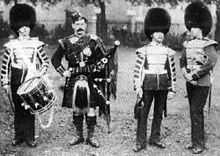Scots Guards
| The Scots Guards | |
|---|---|
 Cap Star of The Scots Guards | |
| Active |
1642-1651, 1661-present |
| Country | United Kingdom |
| Branch | Army |
| Type | Foot Guards |
| Role |
1st Battalion - Armoured Infantry F Company - Public Duties |
| Size |
One battalion One company |
| Part of | Guards Division |
| Garrison/HQ |
RHQ - London 1st Battalion - Catterick F Company - London |
| Nickname | The Kiddies; Jock Guards |
| Motto |
"Nemo Me Impune Lacessit" (Latin) "No one touches me with impunity" |
| March |
Quick - Hielan' Laddie Slow - The Garb of Old Gaul |
| Anniversaries |
St Andrew's Day Nov 30 |
| Commanders | |
| Colonel-in-Chief | HM The Queen |
| Colonel of the Regiment | HRH The Duke of Kent KG, GCMG, GCVO |
| Insignia | |
| Tactical Recognition Flash |
 |
| Tartan | Royal Stewart (pipers kilts and plaids) |
| Plume | none |
| Abbreviation | SG |


The Scots Guards (SG), part of the Guards Division, is one of the Foot Guards regiments of the British Army. Their origins lie in the personal bodyguard of King Charles I of England and Scotland. Its lineage can be traced as far back as 1642, although it was only placed on the English Establishment (thus becoming part of what is now the British Army) in 1686.
The Scots Guards is ranked as the third regiment in the Guards Division; as such, Scots Guardsmen can be recognised by having the buttons on their tunics spaced in threes. The regiment consists of a single operational battalion, which has been based in Catterick since 2008, in the armoured infantry role. However, since 1993, the regiment has also maintained an independent company, F Company, permanently based in Wellington Barracks, London on public duties. It is the custodian of the colours and traditions of the 2nd Battalion, which was placed in permanent suspended animation in 1993 as a result of Options for Change. 1st Battalion will be equipped with Mastiff Vehicles under Army 2020 and be under 12th Armoured Infantry Brigade.[1]
Training
Recruits to the Guards Division go through a thirty week Gruelling training programme at the Infantry Training Centre (ITC) and is one of the hardest basic training courses in the world and produces some of the best soldiers in the world. The training is two weeks more than the training for the Regular line infantry regiments of the British Army; the extra training, carried out throughout the course, is devoted to drill and ceremonies.[2]
History of the Scots Guards
- History of the Scots Guards (1642–1804)
- History of the Scots Guards (1805–1913)
- History of the Scots Guards (1914–1945)
- History of the Scots Guards (from 1946)
Traditions and Affiliations
The Scots Guards and other Guards Regiments have a long standing connection to The Parachute Regiment. Guardsman who have Completed P company are Transferred into the Guards Parachute Platoon who are currently attached to 3 PARA still keeping the tradition of the No 1 (Guards) Independent Parachute Company who were the original Pathfinder Group of 16th Parachute Brigade now renamed 16th Air Assault Brigade.[3]
Battle Honours
- Pre-First World War: Namur 1695, Dettingen, Lincelles, Egypt, Talavera, Barrosa, Fuentes d'Onoro, Salamanca, Nive, Peninsula, Waterloo, Alma, Inkerman, Sevastopol, Tel-er-Kebir, Egypt 1882, Suakin 1885, Modder River, South Africa 1899–1902
- First World War:
- Western Front: Retreat from Mons, Marne 1914, Aisne 1914, Ypres 1914 1917, Langemarck 1914, Gheluvelt, Nonne Bosschen, Givenchy 1914, Neuve Chapelle, Aubers, Festubert 1915, Loos, Somme 1916 1918, Flers Courcelette, Morval, Pilckem, Poelcapelle, Cambrai 1917 1918, St. Quentin, Albert 1918, Bapaume 1918, Arras 1918, Drocourt-Quéant, Hindenburg Line, Havrincourt, Canal du Nord, Selle, Sambre, France and Flanders 1914–18
- Second World War:
- North-West Europe: Stien, Norway 1940, Quarry Hill, Estry, Venlo Pocket, Rhineland, Reichswald, Kleve, Moyland, Hochwald, Rhine, Lingen, Uelzen, North-West Europe 1944–45
- North Africa: Halfaya 1941, Sidi Suleiman, Tobruk 1941, Gazala, Knightsbridge, Defence of Alamein Line, Medenine, Tadjera Khir, Medjez Plain, Grich el Oued, Djebel Bou Aoukaz 1943 I, North Africa 1941–43
- Italy: Salerno, Battipaglia, Volturno Crossing, Rocchetta e Croce, Monte Camino, Campoleone, Carroceto, Trasimene Line, Advance to Florence, Monte San Michele, Catarelto Ridge, Argenta Gap, Italy 1943–45
- Post WWII: Tumbledown Mountain (Falkland Islands 1982), Gulf 1991
_patrolling_near_Musa_Qala%2C_Afghanistan._MOD_45149486.jpg)
References
Alliances
 Australia - 3rd Battalion, Royal Australian Regiment
Australia - 3rd Battalion, Royal Australian Regiment Royal Navy - HMS Duncan
Royal Navy - HMS Duncan
Order of precedence
| Preceded by Coldstream Guards |
Infantry Order of Precedence | Succeeded by Irish Guards |
References
- ↑ http://www.aff.org.uk/linkedfiles/aff/latest_news_information/cregulararmybasingannouncementgridunclas.pdf
- ↑ http://www.army.mod.uk/training_education/training/18158.aspx
- ↑ http://www.paradata.org.uk/units/no-1-guards-independent-parachute-company
External links
| Wikimedia Commons has media related to Scots Guards. |
- The Guards Museum - Containing the history of the five regiments of Foot Guards, Wellington Barracks, London.
| ||||||||||||||||||||||
| ||||||||
